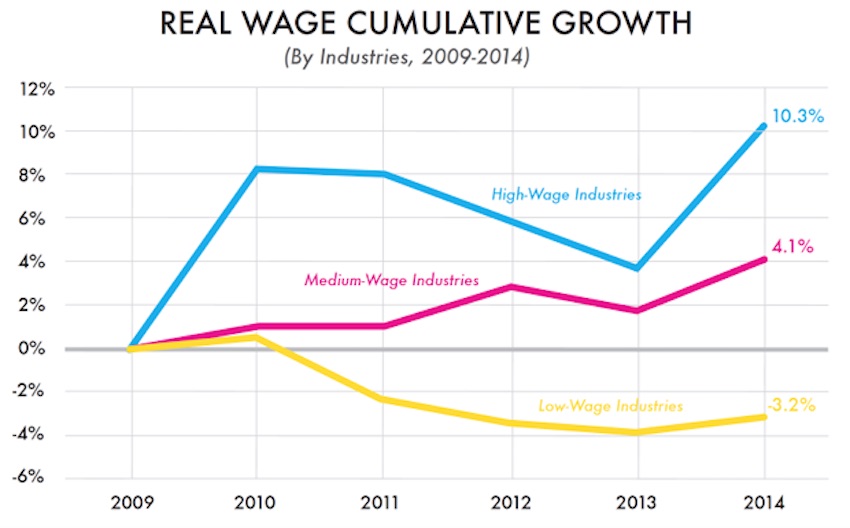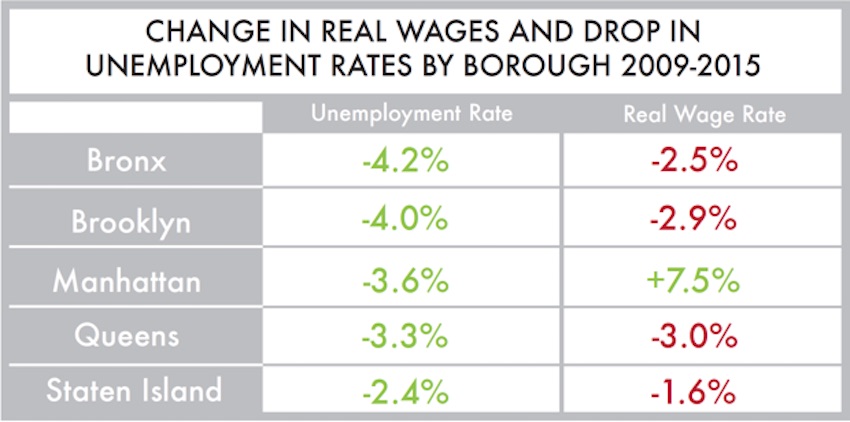Low-wage jobs have increased but the pay hasn’t kept pace with inflation, according to a new report.

The wage gap has been growing in the U.S. since the 1980s, and 2015 saw no departure from this trend. The difference between the highest and lowest wage earners is particularly stark in big cities. In the New York metro area, for example, the top 10 percent of workers make around six times more than the bottom 10 percent of earners, CityLab’s Richard Florida recently found.
Now, a new report released by New York City Comptroller Scott Stringer includes a breakdown of wage growth trends that show why economic growth has been so unequal. Simply put, most of the job growth in the last five years has been in industries that pay very low wages. “Our economic recovery continues to benefit the city and the budget, but not everyone living and working in New York is sharing those benefits,” Stringer said when he presented the report.
Between 2009 and 2015, the city added 525,000 jobs. That’s a good thing, but a majority of the new jobs (57 percent) were created in low-wage industries—a much greater share than the job growth in low-wage industries that occurred between 2003 and 2008 (41 percent). Meantime, shares of jobs in medium- and high-wage industries created between 2009 and 2015 decreased compared to the 2003-2008 period.
In other words, the new jobs created between 2009 and 2015 were more likely to be low-wage than new jobs created in the five years before that. “When you lose high-wage jobs, and replace them with low-wage jobs, you start to lose ground,” Stringer said.
From our partners:
To make it worse, the average wage for these already low-paying jobs dropped by 3 percent between 2009 and 2015, while wages for higher-paying jobs increased in this period. The average wage for the high-wage industries rose the most—by more than 10 percent. Here’s how Stringer put it in his presentation:
“High-income New Yorkers are making even more money, low-income New Yorkers are making even less, because for workers of low-paying industries, wages are not keeping up with inflation—and the proof is in the numbers. Our city is getting less affordable for hardworking families.”

There’s a geographical component to this inequality, too. While each New York City borough has seen a drop in unemployment, Manhattan is the only borough where wages rose from 2009 to 2015. Every other borough saw a decline in inflation-adjusted wages. “Most of the high-wage industries are located in Manhattan,” Stringer said. “New jobs in the other boroughs have been disproportionately in low-wage industries.”

Raising the minimum wage to $15 a dollar is one fix Stringer recommends, and the city has taken some pretty big steps in this direction. In January, Mayor Bill de Blasio announced a $15 minimum wage for city employees, which would benefit 50,000 New Yorkers. But higher minimum hourly wages for all workers, which Governor Andrew Cuomo has been considering, would would go a longer way—both for workers themselves and the state economy.
This feature originally appeared in Citylab.
















